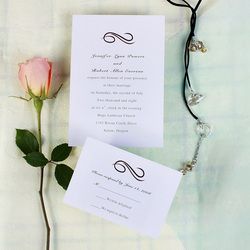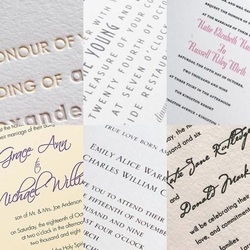An Etiquette on Addressing Wedding Invitations
Addressing your wedding invitations can seem a little confusing at
first. Hopefully this guide will help you easily understand how to
address and assemble your wedding invitations. Include these wordings on your bridal planning list.
Addressing Etiquette
The outer envelope should list the name and complete address of the recipient while the inner envelope lists only the names. No abbreviations should be used when addressing wedding invitations, except for Mr., Mrs., Ms., and Jr. State names should be spelled out.
Type of Guests
Married Couple
Outer envelope: Mr. and Mrs. Ted Jones
Inner envelope: Mr. and Mrs. Jones
If you are invited children under 18 to the wedding, the outer envelope should be addressed to the parents only, as indicated above. The inner envelope should list the children's first names (in order from oldest to youngest) on one line below the parent's names, such as:
Mr. and Mrs. Ted Jones Charles, Michael and Samantha
Children over the age of 18 should receive their own invitation, even if they still live with their parents.
Unmarried Female
Outer envelope: Miss (or Ms.) Susan Smith
Inner envelope: Miss (or Ms.) Smith (and Guest)
Unmarried Male
Outer envelope: Mr. Thomas Lipton
Inner envelope: Mr. Lipton (and Guest)
Addressing Etiquette
The outer envelope should list the name and complete address of the recipient while the inner envelope lists only the names. No abbreviations should be used when addressing wedding invitations, except for Mr., Mrs., Ms., and Jr. State names should be spelled out.
Type of Guests
Married Couple
Outer envelope: Mr. and Mrs. Ted Jones
Inner envelope: Mr. and Mrs. Jones
If you are invited children under 18 to the wedding, the outer envelope should be addressed to the parents only, as indicated above. The inner envelope should list the children's first names (in order from oldest to youngest) on one line below the parent's names, such as:
Mr. and Mrs. Ted Jones Charles, Michael and Samantha
Children over the age of 18 should receive their own invitation, even if they still live with their parents.
Unmarried Female
Outer envelope: Miss (or Ms.) Susan Smith
Inner envelope: Miss (or Ms.) Smith (and Guest)
Unmarried Male
Outer envelope: Mr. Thomas Lipton
Inner envelope: Mr. Lipton (and Guest)
The "and Guest" is optional when inviting single friends to your
wedding. However if the person is in a serious relationship, it's
proper etiquette to allow him/her to bring a guest.
Unmarried couples who live together should receive one invitation, where their names are listed on separate lines in alphabetical order. Unmarried couples who live separately should receive one invitation addressed to the guest who is closest to you on the outer envelope. On the inner envelope, both names should be listed on separate lines in alphabetical order.
Medical Doctor (Married)
Outer envelope: Doctor and Mrs. Larry Thompson
Inner envelope: Doctor and Mrs. Thompson
Medical Doctor (Unmarried)
Outer envelope: Doctor Larry Thompson
Inner envelope: Doctor Thompson (and Guest)
Doctor (PhD, Married)
Outer envelope: Dr. and Mrs. William Fremont
Inner envelope: Dr. and Mrs. Fremont
Doctor (PhD, Unmarried)
Outer envelope: Dr. William Fremont
Inner envelope: Dr. Fremont (and Guest)
Sending Your Wedding Invitations
Order your wedding invitations three to four months prior to your wedding. Order 20% more than your number of guests to allow for errors and additions. Send the wedding invitations six to eight weeks before your wedding date.
Assembling Your Wedding Invitations
Ask your mother or your maid-of-honor to help you assemble the wedding invitations. Lay everything out on a long table in assembly line fashion. If your invitations are single fold and the wording is on the outside of the invitation only, then your enclosures are placed on top of the invitation. If your invitations are multi-fold and/or the wording is inside the fold then enclosures are placed inside the first fold.
Enclosures are placed in the following order from the bottom to the top:
Tissue paper
Do not seal the inner envelope.
Place the inner envelope inside the outer envelope with its flap facing the front of the outer envelope.
Before you begin, count all the parts of the invitations to make sure you are starting with equal amounts. Assemble each invitation as indicated above but do not seal the outer envelopes. Once you are done assembling the invitations, make sure all your counts are even. If they are, you can seal the outer envelopes. If not, you have made a mistake and will need to find which envelope is missing a component.
Unmarried couples who live together should receive one invitation, where their names are listed on separate lines in alphabetical order. Unmarried couples who live separately should receive one invitation addressed to the guest who is closest to you on the outer envelope. On the inner envelope, both names should be listed on separate lines in alphabetical order.
Medical Doctor (Married)
Outer envelope: Doctor and Mrs. Larry Thompson
Inner envelope: Doctor and Mrs. Thompson
Medical Doctor (Unmarried)
Outer envelope: Doctor Larry Thompson
Inner envelope: Doctor Thompson (and Guest)
Doctor (PhD, Married)
Outer envelope: Dr. and Mrs. William Fremont
Inner envelope: Dr. and Mrs. Fremont
Doctor (PhD, Unmarried)
Outer envelope: Dr. William Fremont
Inner envelope: Dr. Fremont (and Guest)
Sending Your Wedding Invitations
Order your wedding invitations three to four months prior to your wedding. Order 20% more than your number of guests to allow for errors and additions. Send the wedding invitations six to eight weeks before your wedding date.
Assembling Your Wedding Invitations
Ask your mother or your maid-of-honor to help you assemble the wedding invitations. Lay everything out on a long table in assembly line fashion. If your invitations are single fold and the wording is on the outside of the invitation only, then your enclosures are placed on top of the invitation. If your invitations are multi-fold and/or the wording is inside the fold then enclosures are placed inside the first fold.
Enclosures are placed in the following order from the bottom to the top:
Tissue paper
- Reception card
- Map
- Response envelope (self-addressed and stamped)
- Response card tucked neatly under the flap of the response envelope
Do not seal the inner envelope.
Place the inner envelope inside the outer envelope with its flap facing the front of the outer envelope.
Before you begin, count all the parts of the invitations to make sure you are starting with equal amounts. Assemble each invitation as indicated above but do not seal the outer envelopes. Once you are done assembling the invitations, make sure all your counts are even. If they are, you can seal the outer envelopes. If not, you have made a mistake and will need to find which envelope is missing a component.


